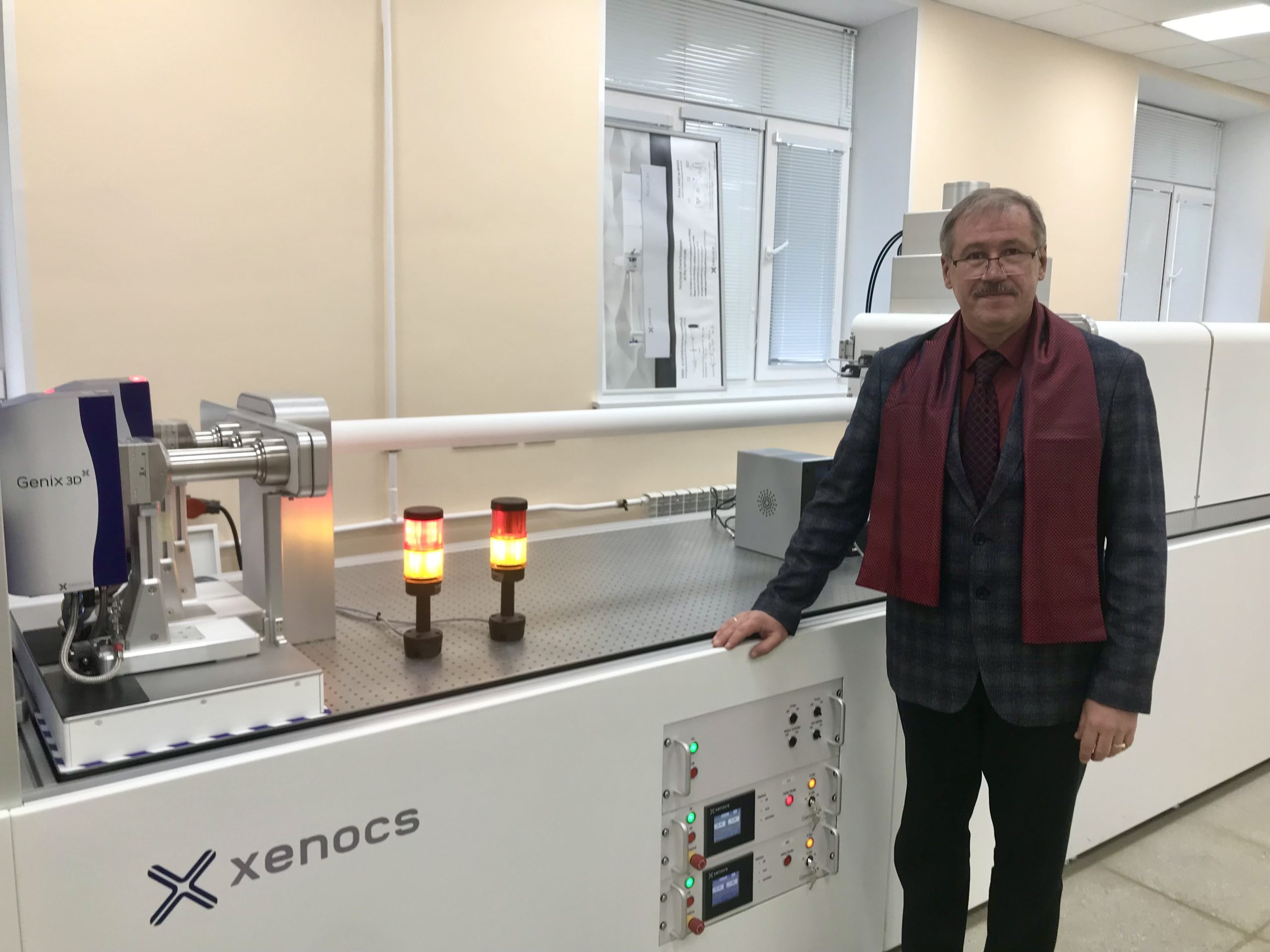Humanity has high hopes for nanotechnologies. Industry, energy, space studies, medicine, human rescue, offshore oil production, equipment of athletes – all these and many other industries are already rapidly changing and promise to become even more effective thanks to nanotechnologies. With the development of materials science, more and more nanomaterials are becoming objects of studies at the new Xeuss 3.0 X-ray scattering station in FLNP JINR since it is at this facility at which scientists study the structure of nanomaterials on which their properties depend.
One of the first invited users of the station was a senior researcher of Petersburg Nuclear Physics Institute n.a. B. P. Konstantinov (PNPI) Gennady Kopitsa in June 2021. His close cooperation with FLNP JINR has been developing since then. “I would say that this is the best laboratory facility operating with the use of both small-angle and wide-angle X-ray scattering. The station makes it possible to study the structure of various materials and nanomaterials from atoms to nanoscale,” Gennady Petrovich noted the advantages of the station. His scientific interests include the study into the structure and properties of nanomaterials.

The device allows studying materials in various aggregate states. For this purpose, there is plenty of sample holders at the station: for liquids, gels, powders, films, and biological objects in solutions. Another feature of the facility that attracts scientists engaged in nanomaterials studies is a molybdenum anode. In particular, it was yet another argument in favour of the Xeuss 3.0 facility in FLNP for the scientist from the PNPI who jointly with his colleagues from the Institute of Silicate Chemistry RAS (St. Petersburg) conducted research of magnetic nanopowders of iron oxides. Such nanopowders are widely used in biological and agricultural technologies. For example for seed treatment. It is due to the fact that this nanomaterial contains iron, which is a necessary component in plant processes. In addition to nanopowders, specialists have studied nanodiamonds of denotation synthesis at Xeuss 3.0. This material may used in agricultural sector as well. Works on the synthesis of materials for agricultural technologies, including these studies, were supported by an RSF grant. Results of the study of these nanomaterials at FLNP device have resulted in a number of joint with the Laboratory publications.
Other nanomaterials that Gennady Kopitsa has studied at the Xeuss 3.0 station are gels. Using various soft chemistry methods to obtain them, specialists set different properties for gels. For example, aerogels have high porosity: pores take from 90 to 99% of the material structure. So, aerogels may be used as sorbents, they possess high electrical conductivity and low thermal conductivity, etc. That is why there is a variety of fields for their use. “We have recently measured so-called binary aerogels, in particular, aluminum-titanium ones,” Gennady Kopitsa notes. “They are widely used in cosmetic industry. Work in this direction continues.” PNPI scientists have used the X-ray scattering station to study inverted aerogels, which are the combination of aerogels with polymers. Jointly with colleagues from the Kurnakov Institute of General and Inorganic Chemistry RAS (Moscow), researchers have studied the structure of ionogels that are a new class of hybrid materials containing an ionic liquid immobilised into a solid matrix. Having high electrical conductivity along with elasticity and resistance to high temperatures, they may be, for example, an excellent conductive element that can be given different shapes. FLNP and PNPI scientists jointly with colleagues from Serbia have studied also carbon cryo-gel. This work is an excellent example of the use of complementary research methods: small-angle neutron scattering and X-ray radiation, including the contrast variation method. These methods allowed discovering the nature as well as the ratio of open and closed pores, the supramolecular structure of the cryogel.
“The X-ray station in FLNP has a good sensitivity to the phase boundaries and a high beam resolution of about 300 nanometers. This makes it possible to conduct more accurate structural studies. Moreover, the fluxes at the facility are higher than those from neutrons,” the PNPI scientist highlights.
Specialists also study polymers at Xeuss 3.0. There is a variety of their types, just like of gels, and the important peculiarity of many polymers is that they may have a shape memory effect. This is useful for industrial purposes. Bacterial cellulose-based materials are also promising. They are actively synthesised and studied now. Bacterial cellulose is a natural biopolymer, a product of bacterial vital activity. The bulk of cellulose products is now produced from this nanomaterial. It has a fibrillar structure, i.e. the structure with elongated “rods”, that are assembled into so-called nanofilms. Such a structure determines the ability of bacterial cellulose to gain up to 100 ml of water for only 1 g of its weight. To prepare this nanomaterial to the practical use, it should be pre-dried. PNPI scientists have used the FLNP JINR station to study how various drying methods influence the structure and, therefore, the properties of bacterial cellulose. A number of publications will be devoted to this topic. One of the current tasks at the Xeuss 3.0 facility is the study of properties of bacterial cellulose dried using the soft lyophilic method: the sample is first frozen, then put into the vacuum chamber for sublimation, and after that annealed at 2,000 °C in an inert atmosphere. After such manipulations, specialists get pyrolytic graphite of high conductivity, which is promising for industrial purposes.
Among other latest research by the PNPI scientist, there were also measurements of membranes for hydrogen energy. Scientists from all over the world are trying to modify them or invent their analogues. Gennady Petrovich has yet to process the results obtained at the Xeuss 3.0 station.
“Dubna is everything for us: there are no such facilities in Russia, and the competence level of colleagues from JINR is very high,” Gennady Kopitsa highlighted.
The unique station Xeuss 3.0 manufactured by the French company XENOCS was brought to FLNP JINR in April 2022. In a month, specialists were already conducting test measurements. The user programme of the station is under development now, however since the facility’s installation in FLNP, JINR scientists and researchers from a number of scientific organizations of Russia, the JINR location country, have been carrying out research at it. Xeuss 3.0 allows conducting almost the entire range of JINR research with the use of neutron scattering methods. Plans of FLNP JINR include the adjustment of the facility for measurements at different temperatures, which will then expand the possibilities of nanomaterials study.
Source: Joint Institute for Nuclear Research
Click here to read more about Xeuss 3.0!
The Next Generation (GI-)SAXS/WAXS/USAXS beamline for the laboratory – Xeuss 3.0
